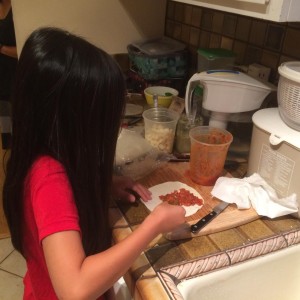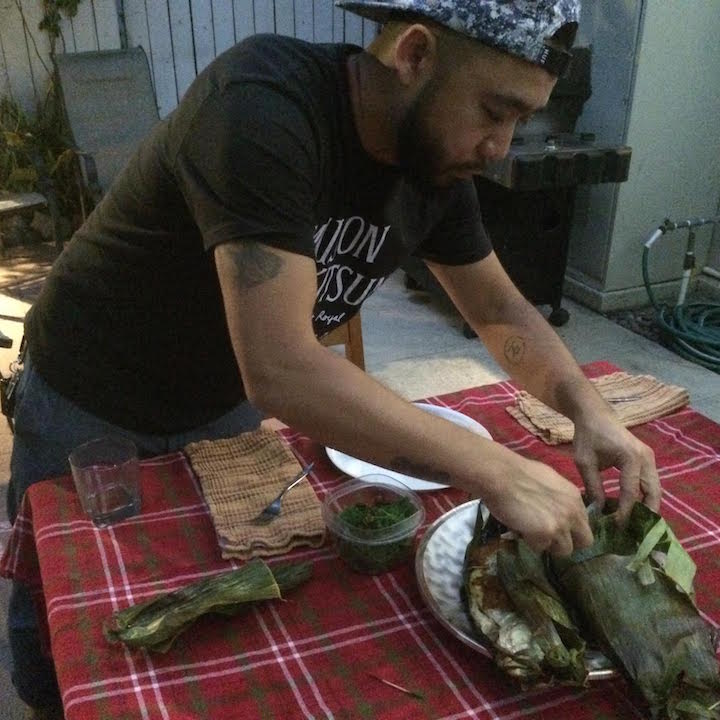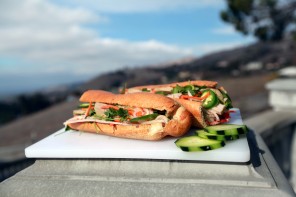We’re not supposed to judge books by their cover but how about their titles? It feels deliciously brazen of former Top Chef standout Dale Talde, along with J.J. Goode, to name their new cookbook Asian-American, not the least of which is because they’re the first to do it. And before you can ask “yeah but what does that even mean?” the subtitle is already prepared for you: “Proudly Inauthentic Recipes From the Philippines to Brooklyn.” With one deft prefix, they disarm the most frequent – and laziest – criticism that’s inevitably thrown at any “ethnic” recipe: “that’s not authentic.”
Food authenticity is a familiar enough debate but a deeply banal and pointless one since it’s premised on mystical heritages and narrow imaginations. Dubious Gastronomy author Robert Ku astutely notes that, especially when it comes to Asian food in America, “the burden, if not blame, of Asian inauthenticity falls most heavily on the shoulders of Asian Americans,” given our liminal state as racialized citizens. Talde avoids this imbroglio by embracing the apocryphal, refusing to sell the reader a hoary pitch of “pancit like my lola made.” He doesn’t even bother to offer a pancit recipe.
Ku describes authenticity as “both an illusion and a trap” and Asian-American lays out a trap of its own with the title. The eye is naturally drawn to the “Asian” modifier but Talde’s food is ultimately about investigating and expanding the meaning of American cuisine itself, beyond the hot dogs and hamburgers he and his father would eat behind his health-minded mother’s back. Just as central in Talde’s chain of influences are “gyro shops, Polish delis” as well as “shawarma and roti, tacos and yakitori,” that this Brooklynite by-way-of Chicago grew up on.
Talde’s brief but provocative chapter, “The New Asian-American Cuisine,” isn’t a detailed manifesto but instead, sketches out a sensibility for what he describes as “Generation Steamed Bun.” i.e. the children of immigrants “raised on take-out pad thai and egg rolls.” Talde says of his own recipes that it’s “food…meant to remind you that you’re home” except “home” isn’t the homeland of one’s parents or grandparents but rather the metaphysical idea of home created through the experiences of growing up Asian American. Home is where suburban mini-malls, aging enclaves and gentrifying urban districts all inform a polyglot sense of culinary identity. Home is where there’s an unruly drawer of takeout menus from a dozen different Asian eateries, faded ink circles around the numbers of favorite menu items. Home is where you’re nervous to have your in-laws try your cooking but you ask friends over to test out your red-braised pork recipes.
All of which is to say, I get where Talde is coming from but more important than what that vision looks like is the essential question of: what does it taste like? As it is, Talde’s prepared for that too, offering a list of instructions for how best to work one’s way through “Asian-American.” Step One: “Invite a bunch of friends over.”
Our Sunday dinner party wasn’t deliberately engineered to be pan-Asian but we still ended up with Chinese, Filipino, Japanese and Korean friends in the mix. That included filmmaker Grace Lee (Off the Menu) and my lunch buddy, Patrick “DJ Phatrick” Huang, plus their families. I also asked a solid of my friend Leonard Shek, who worked under Susur Lee at New York’s Shang and helped Jonathan Wu open Fung Tu. A quick peruse of Talde’s recipes confirmed that I’d quickly be in over my head so I lent the book to Leonard and had him pick out the recipes to make for the rest of us.
He had a good time going through it; “As a line cook that worked in NYC kitchens, I found there to be a culture of trashy food experimentation,” Leonard shared. “Asian-American seems almost like a community church cookbook from the meatpacking to the Bowery. It’s the kind of stuff you grab on your way into work between Chinatown and Nolita, to make a snack during that slow hour before service.”
 Leonard started us off with the two dishes, including the amuse-bouche at Talde’s eponymous restaurant in Brooklyn: bacon-tamarind caramel wrapped in a perilla leaf. He also enlisted the kids in the house to help him prep what amounted to roti pizza pockets, made with frozen roti, cubed mozzarella and Talde’s pepperoni marinara sauce. Once those came hot out the oven, we dug into both.
Leonard started us off with the two dishes, including the amuse-bouche at Talde’s eponymous restaurant in Brooklyn: bacon-tamarind caramel wrapped in a perilla leaf. He also enlisted the kids in the house to help him prep what amounted to roti pizza pockets, made with frozen roti, cubed mozzarella and Talde’s pepperoni marinara sauce. Once those came hot out the oven, we dug into both.
The roti calzones reflect Talde’s admitted love of junk/fast/stoner food and his take isn’t aspiring to be a “refined” version, just one that’s easy to make and comforting to eat in a late-night munchies way. Notably though, besides the kids, no one else reached for seconds. In contrast, the bacon-tamarind caramel was a huge hit, not the least of which because it involved “bacon” and “caramel.” This brings up Talde’s Step Two: “Flip to the Sauces.”
I have to confess: I love sauces but I hate making them. I get stressed simply trying to boil rice and roast vegetables at the same time, let alone trying to micro-manage a sauce recipe that requires a dozen different ingredients, in precise measurements, and leaves behind more turmeric powder than I know what to do with. Thankfully, Leonard took up the burden but he noted he had to hit up three or four different supermarkets to find everything since even the large Chinese and Korean markets here in L.A. carried some ingredients but lacked others. Talde, always the seer in this book, predicts that potential frustration too, warning in some cases, “this [sauce] is a little annoying to make at home” and elsewhere, permits the reader to “Get Lazy” by taking shortcuts when necessary.
Besides the sweet-salty bacon caramel, Leonard also made a tomato jam to go with Talde’s Vietnamese steamed fish taco recipe and a green sambal – that was one with the “annoying” alert – that was initially served with roasted brussels sprouts. The fish tacos were the biggest hit: striped bass steamed inside of banana leaves, topped with a salad’s worth of basil, cilantro and dill. The aforementioned tomato jam was heavy with coriander, fish sauce and lime juice. The soft texture of the bass, mixed in with the umami-bomb of the jam and the light bite of the herbs was perfect, whether wrapped inside lettuce leaves or the best store-bought corn tortillas I’ve ever had (Boyle Heights, respect). The brussels sprouts were less exciting initially. Tossed with the green sambal, they tasted fine but overall, the dish felt slightly underseasoned. However, that sauce began to shine once we followed Talde’s Step Three: “flip the script.”
Talde encourages readers to try different sauces with whatever you like. Leonard also brought some store-marinated kalbi ribs which I gave a quick toss on the grill and people quickly wrapped those into tacos and then mixed-matched different sauces. The green sambal added a Southeast Asian tang to the sweet saltiness of the short rib marinade. Added to the fish in place of the tomato jam, the sambal became reminiscent of the ginger sauce you get with Hainan chicken rice (even though it has no ginger in it) and it well complemented the bass’s natural, subtle flavors. Likewise, the tomato jam easily transported itself to the kabli, its brightness cutting across the unctuousness of the short rib. As for the bacon caramel spread, sufficed to say, you could throw that on anything (or just eat it by the spoonful).
Someone at the table pointed out that this is what felt most Asian American about the experience: the un-self-conscious way in which most of us will raid our fridges to mash together various leftovers and then splash whatever Asian condiments we have on hand, irrespective of cultural origins. There’s a reason why many of our households have a perpetually empty bottle of rooster sauce sitting on our kitchen table or will dash a little fish sauce into any random recipe.
Perhaps that’s why Talde’s sauce section is so extensive, with nearly 30 recipes in that chapter alone. Many of them feel deliberately playful or, for lack of a less hackneyed term, fusion-y: wasabi salsa verde, Chinese-sausage gravy, kimchi yogurt. However, as Talde urges, whatever sauce you use isn’t beholden to any specific pairing or application. That’s the whole point of flipping the script: it’s about experimentation and play. The Asian American-ness of it isn’t from a flavor profile; it’s from a practice that we all understand even when we don’t always realize we’re doing it. Leonard added, “as someone who grew up in the Bay Area with Japanese, Pilipino, Vietnamese, and Hawaiian, flipping through the recipes felt really familiar. Seeing the ingredients he uses and how their tied to his own stories made nostalgic for my own experiences.” Many at the table could relate to that.
All this said, Asian-American still feels daunting as a cookbook, at least for someone like me who is an amateur in the kitchen. Many of the recipes call for 1-2 dozen ingredients, split between 2-3 components. There’s also a general presumption that the reader has easy access to Asian vegetables, spices and sauces. That may be the case in certain coastal cities but if you’re in Spokane or Little Rock? Good luck. Ultimately, I was less interested in the recipes themselves than simply reading how Talde talked about them. He sprinkles in entertaining anecdotes about the physics of cooking with a wok or why one shouldn’t fear MSG or why he still “chases the dragon” that is McDonald’s McNuggets. However delicious his dishes and sauces may be (at least when you have someone else cooking them for you), it’s his voice and perspective that I enjoyed consuming the most.
Asian Americans have been writing cookbooks for decades but Talde’s is one of the first to so explicitly frame it in terms of an Asian American cooking practice, however amorphously defined. There’s every reason to expect that many others will follow with their own takes on that malleable concept and I’m looking forward to all the future dinner parties where we get to test (and taste) this emergent wave of ideas.
+ + +
Oliver Wang is an associate professor of sociology at CSU-Long Beach and author of Legions of Boom: Filipino American Mobile DJ Crews of the San Francisco Bay Area.
MORE
RECIPE: Dale Talde’s “Pepperoni Pizza ‘Very Warm’ Pockets”
 This story is a part of Off the Menu: Asian America, a multimedia project between the Center for Asian American Media and KQED, featuring a one-hour PBS primetime special by filmmaker Grace Lee (The Grace Lee Project, American Revolutionary), original stories and web content.
This story is a part of Off the Menu: Asian America, a multimedia project between the Center for Asian American Media and KQED, featuring a one-hour PBS primetime special by filmmaker Grace Lee (The Grace Lee Project, American Revolutionary), original stories and web content.




